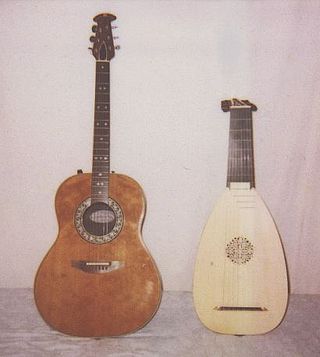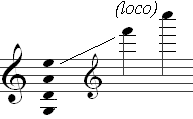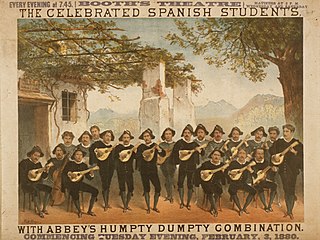
The vihuela is a 15th-century fretted plucked Spanish string instrument, shaped like a guitar but tuned like a lute. It was used in 15th- and 16th-century Spain as the equivalent of the lute in Italy and has a large resultant repertory. There were usually five or six doubled strings.

The guitarrón mexicano (Spanish for "big Mexican guitar", the suffix -ón being a Spanish augmentative) or Mexican guitarrón is a very large, deep-bodied Mexican six-string acoustic bass guitar played traditionally in Mariachi groups. Although similar to the guitar, it is not a derivative of that instrument, but was independently developed from the sixteenth-century Spanish bajo de uña ("fingernail[-plucked] bass"). Because its great size gives it volume, it does not require electric amplification for performances in small venues. The guitarrón is fretless with heavy gauge strings, most commonly nylon for the high three and wound metal for the low three. The guitarrón is usually played by doubling notes at the octave, a practice facilitated by the standard guitarrón tuning A1 D2 G2 C3 E3 A2. Unlike a guitar, the pitch of the guitarrón strings does not always rise as strings move directionally downward from the lowest-pitched string (A2, which is the 6th string from the lowest-pitched string, is a perfect 5th below its adjacent string E3).

The mandocello is a plucked string instrument of the mandolin family. It is larger than the mandolin, and is the baritone instrument of the mandolin family. Its eight strings are in four paired courses, with the strings in each course tuned in unison. Overall tuning of the courses is in fifths like a mandolin, but beginning on bass C (C2). It can be described as being to the mandolin what the cello is to the violin.

The bandurria is a plucked chordophone from Spain, similar to the mandolin and bandola, primarily used in Spanish folk music, but also found in former Spanish colonies.

The bandola is one of many varieties of small pear-shape chordophones found in Venezuela and Colombia. They are related to the bandurria and mandolin.

Plucked string instruments are a subcategory of string instruments that are played by plucking the strings. Plucking is a way of pulling and releasing the string in such a way as to give it an impulse that causes the string to vibrate. Plucking can be done with either a finger or a plectrum.
An acoustic guitar is a musical instrument in the string family. When a string is plucked, its vibration is transmitted from the bridge, resonating throughout the top of the guitar. It is also transmitted to the side and back of the instrument, resonating through the air in the body, and producing sound from the sound hole. While the original, general term for this stringed instrument is guitar, the retronym 'acoustic guitar' – often used to indicate the steel stringed model – distinguishes it from an electric guitar, which relies on electronic amplification. Typically, a guitar's body is a sound box, of which the top side serves as a sound board that enhances the vibration sounds of the strings. In standard tuning the guitar's six strings are tuned (low to high) E2 A2 D3 G3 B3 E4.

The jota is a genre of music and the associated dance known throughout Spain, most likely originating in Aragon. It varies by region, having a characteristic form in Aragon, Mallorca, Catalonia, León, Castile, Navarre, Cantabria, Asturias, Galicia, La Rioja, Murcia and Eastern Andalusia. Being a visual representation, the jota is danced and sung accompanied by castanets, and the interpreters tend to wear regional costumes. In Valencia, the jota was once danced during interment ceremonies.

In Spain, Portugal and Latin American countries, a tuna is a group of university students in traditional university dress who play traditional instruments and sing serenades. The tradition originated in Spain and Portugal in the 13th century as a means of students to earn money or food. Nowadays students don't belong to a "tuna" for money or food; rather, they seek to keep a tradition alive, for fun, to travel a lot and to meet new people from other universities. A senior member of a tuna is a "tunante", but is usually known simply as a "tuno". The word "tuno" also refers to anyone who is a member of a tuna, although the first meaning is more common among tunas. New tuna members are known as "caloiros", "novatos" or "pardillos."

The mandore is a musical instrument, a small member of the lute family, teardrop shaped, with four to six courses of gut strings and pitched in the treble range. Considered a French instrument, with much of the surviving music coming from France, it was used across "Northern Europe" including Germany and Scotland. Although it went out of style, the French instrument has been revived for use in classical music. The instrument's most commonly played relatives today are members of the mandolin family and the bandurria.

Laúd is a plectrum-plucked chordophone from Spain, played also in diaspora countries such as Cuba and the Philippines.

Antonio Membrado was a Spanish classical guitarist and composer resident in France since 1959. He was a student of Andrés Segovia and gave many concerts in France and abroad.

A conchera or concha is Mexican stringed-instrument, plucked by concheros dancers. The instruments were important to help preserve elements of native culture from Eurocentric-Catholic suppression. The instruments are used by concheros dancers for singing at velaciones and for dancing at obligaciones.

The octavina or Ecuadorian-Peruvian octavina is a guitar-shaped Ecuadorian-Peruvian instrument with a tuning similar to the laúd. Originally a Spanish instrument, the octavina was soon incorporated into other cultures, notably including culture of Ecuador and culture of Peru.

The Spanish Students was a musical group from Madrid which popularized the tuna form of traditional student bands. It gained international recognition after performing at the Carnival of Paris and the Paris Exposition of 1878. Under the name Estudiantina Española Fígaro, members of the original group toured France, Germany, Russia, Italy, Holland and England. After two years touring Europe, some members also toured North and South America in 1880.

Lutes are stringed musical instruments that include a body and "a neck which serves both as a handle and as a means of stretching the strings beyond the body".

The mandolin has had a place in North American culture since the 1880s, when a "mandolin craze" began. The continent was a land of immigrants, including Italian immigrants, some of whom brought their mandolins with them. In spite of the mandolin having arrived in America, it was not in the cultural consciousness until after 1880 when the Spanish Students arrived on their international performing tour. Afterwards, a "mandolin craze" swept the United States, with large numbers of young people taking up the instrument and teachers such as Samuel Siegel touring the United States. The fad died out after World War I, but enough had learned the instrument that it remained. The mandolin found a new surge with the music of Bill Monroe; the Gibson F-5 mandolin he played, as well as other archtop instruments, became the American standard for mandolins. Bowlback mandolins were displaced. The instrument has been taken up in blues, bluegrass, jug-band music, country, rock, punk and other genres of music. While not as popular as the guitar, it is widespread across the country.

The mandolin is a modern member of the lute family, dating back to Italy in the 18th century. The instrument was played across Europe but then disappeared after the Napoleonic Wars. Credit for creating the modern bowlback version of the instrument goes to the Vinaccia family of Naples. The deep bowled mandolin, especially the Neapolitan form, became common in the 19th century, following the appearance of an international hit, the Spanish Students. They toured Europe and America, and their performances created a stir that helped the mandolin to become widely popular.

Following its invention and development in Italy the mandolin spread throughout the European continent. The instrument was primarily used in a classical tradition with mandolin orchestras, so called Estudiantinas or in Germany Zupforchestern, appearing in many cities. Following this continental popularity of the mandolin family, local traditions appeared outside Europe in the Americas and in Japan. Travelling mandolin virtuosi like Carlo Curti, Giuseppe Pettine, Raffaele Calace and Silvio Ranieri contributed to the mandolin becoming a "fad" instrument in the early 20th century. This "mandolin craze" was fading by the 1930s, but just as this practice was falling into disuse, the mandolin found a new niche in American country, old-time music, bluegrass and folk music. More recently, the Baroque and Classical mandolin repertory and styles have benefited from the raised awareness of and interest in Early music.




















